IASbaba's Daily Current Affairs Analysis
Archives
(PRELIMS & MAINS Focus)
Syllabus
- Prelims – Environment and Ecology
Context: Coming to the rescue of the critically endangered Great Indian Bustard (GIB), the Supreme Court recently mooted the idea of launching ‘Project GIB’ on the lines of ‘Project Tiger’, which was started in 1973 to save the big cats, and sought the government’s view on the proposal.
About Great Indian Bustard:
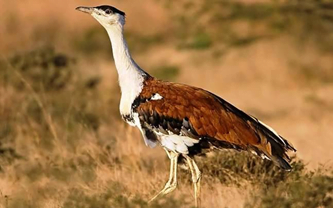
- Common Name: Great Indian bustard
- Scientific Name: Ardeotis nigriceps
- Population: 200 individuals worldwide
- Height: 100 cms or 1 metre
- Length: Wingspan of 210-250 cm
- Weight: 15-18 kg
- Status: Listed in Schedule I of the Indian Wildlife (Protection)Act, 1972, in the CMS Convention and in Appendix I of CITES, as Critically Endangered on the IUCN Red List and the National Wildlife Action Plan (2002-2016).
- It has also been identified as one of the species for the recovery programme under the Integrated Development of Wildlife Habitats of the Ministry of Environment and Forests, Government of India.
Characteristics:
- The body is brownish and the wings are marked with black, brown and grey.
- Males and females generally grow to the same height and weight but males have larger black crowns and a black band across the breast.
- They breed mostly during the monsoon season when females lay a single egg on open ground. Males play no role in the incubation and care of the young, which remain with the mother till the next breeding season.
- Their diet ranges widely depending on the seasonal availability of food. They feed on grass seeds, insects like grasshoppers and beetles, and sometimes even small rodents and reptiles.
HABITAT AND DISTRIBUTION
- Historically, the great Indian bustard was distributed throughout Western India, spanning 11 states, as well as parts of Pakistan.
- Its stronghold was once the Thar desert in the north-west and the Deccan plateau of the peninsula.
- Presently, its population is confined mostly to Rajasthan and Gujarat.
Conservation Issues:
- The biggest threat to this species is hunting, which is still prevalent in Pakistan.
- This is followed by occasional poaching outside Protected Areas, collisions with high tension electric wires, fast moving vehicles and free-ranging dogs in villages.
- Other threats include habitat loss and alteration as a result of widespread agricultural expansion and mechanized farming, infrastructural development such as irrigation, roads, electric poles, as well as mining and industrialization.
World Wildlife Fund (WWF) – India’s Initiatives:
- WWF-India has provided inputs in developing the ‘Guidelines for the State Action Plan for Resident Bustard Recovery Programme’.
- It has played an important role in raising awareness about the declining populations and highlighting the importance of implementing a focused bustard conservation programme at the national level.
- WWF-India, is undertaking initiatives towards conservation of GIB in and around Desert National Park.
Source: Press Trust of India
Previous Year Questions
Q.1) With reference to India’s Desert National Park, which of the following statements are
correct? (2020)
- It is spread over two districts.
- There is no human habitation inside the Park.
- It is one of the natural habitats of the Great Indian Bustard.
Select the correct answer using the code given below:
- 1 and 2 only
- 2 and 3 only
- 1 and 3 only
- 1, 2 and 3
Syllabus
- Prelims – Governance
Context: The World Health Organisation (WHO) recently announced that it would start using the term “mpox” for monkeypox, which has infected about 80,000 people in the first major outbreak of the viral disease outside Africa that began early this summer. The disease spread mainly in the Americas including the United States and Europe, primarily among men who have sex with men (MSM).
About Mpox:
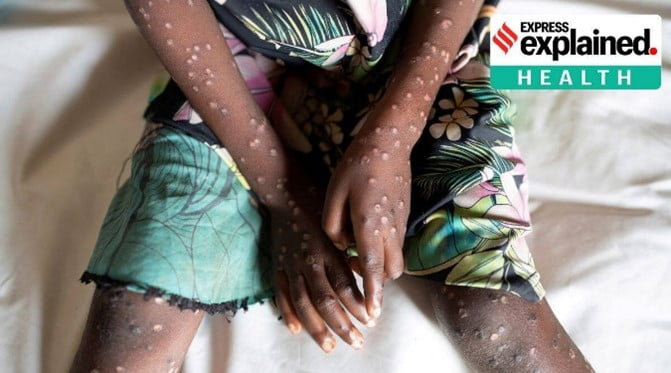
- It is a viral zoonotic disease that occurs primarily in tropical rainforest areas of Central and West Africa.
- Caused by monkeypox virus, a member of the Orthopoxvirus genus in the family Poxviridae.
- The clinical presentation of monkeypox resembles that of smallpox, a related orthopoxvirus infection which was declared eradicated worldwide in 1980.
Symptoms:
- Fever
- Rash and swollen lymph nodes
- Headaches and nausea
Transmission:
- Mostly transmitted to people from wild animals such as rodents and primates.
- Human-to-human transmission also occurs.
- Monkeypox virus is transmitted from one person to another by contact with lesions, body fluids, respiratory droplets and contaminated materials such as bedding.
Outbreaks:
- The first case of monkeypox was reported in 1958 in monkeys and in humans in 1970 in the western Africa.
- Nigeria witnessed the biggest outbreak of the disease in 2017.
- Thereafter, the disease has been reported in many countries including the USA, Singapore, UK.
Difference from smallpox:
- The main difference between symptoms of smallpox and monkeypox is that the latter causes lymph nodes to swell (lymphadenopathy) while smallpox does not.
Present Cases:
- The majority of reported cases of monkeypox currently are in males, and most of these cases occur among males who identified themselves as gay, bisexual and other men who have sex with men (MSM), in urban areas, and are clustered in social and sexual networks.
Source: Indian Express
Previous Year Question
Q.1) Consider the following diseases:
- Diphtheria
- Chickenpox
- Smallpox
Which of the above diseases has/have been eradicated in India? (2014)
- 1 and 2 only
- 3 only
- 1, 2 and 3
- None
Syllabus
- Prelims – Art and Culture
Context: Recently the Prime Minister of India addressed the Manipur Sangai Festival via video message.
About Sangai Festival:
- The festival is named after the state animal, Sangai, the brow-antlered deer found only in Manipur.
- Sangai festival is an annual cultural festival organised by Manipur Tourism Department every year.
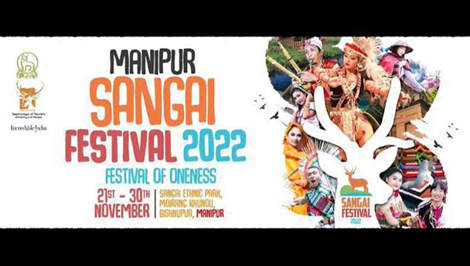
- Many editions of this Festival has been celebrated over the past few years with the name of Tourism Festival, since 2010 this has been renamed as the Sangai Festival.
- This festival is being celebrated to promote Manipur as a world class tourism destination.
- It showcases the states contributions to:
- art and culture,
- handloom,
- handicrafts,
- fine arts,
- indigenous sports,
- cuisine,
- music and adventure sports,
- natural environment.
Source: PIB
Syllabus
- Prelims –Environment
In news: The State of the Climate in Asia 2021 report published by the World Meteorological Organization (WMO) and the UN Economic and Social Commission for Asia and the Pacific (UNESCAP) has been released.
Findings of the report:
- India suffered a total loss of $3.2 billion from floods and $4.4 billion from storms in 2021 as climate change has made these events more frequent.
- During 2021, India experienced five cyclonic storms with maximum sustained wind speeds of ≥ 34 knots
- Extremely severe cyclonic storm Tauktae (May) formed over Arabian Sea during pre-monsoon season was the most devastating.
- Severe Cyclonic Storm Yaas (May) hit West Bengal and northern Odisha, causing damages worth Rs 20,000 crore and Rs 600 crore, respectively.
- Cyclone Gulab (September) landed on the Andhra Pradesh and Odisha coasts, accumulated damages to the tune of Rs 2,000 crore.
- Cyclone Shaheen was formed from the remnants of Gulab and caused heavy rainfall in Gujarat.
- Cyclonic Storm Jawad, causing heavy rainfall over the eastern coast.
- Thunderstorms and lightning claimed around 800 lives in the country.
- India was only second to China in Asia. China suffered the highest economic loss in Asia ($18.4 billion) after flooding.
- Floods and storms accounted for 80 per cent of the natural disasters that struck Asia in 2021.
- Ocean warming could contribute to sea level rise, alter storm paths and ocean currents and increase stratification, the report warned.
- Upper-ocean warming is important because it directly affects the atmosphere in terms of convection, winds, cyclones etc.
- The deep ocean does not affect the atmosphere directly
- Warming is particularly strong in the Arabian Sea because it has pathways to receive excess heat through atmospheric tunnels and bridges. Mixed warm water from various oceans is pumped into it.
- These regions are warming more than three times faster than the global mean upper-ocean warming rate
- Kuroshio Current takes warm water from the tropics and stronger winds force more heat into the current.
- Excessive rainfall due to La Nina – During this time, the pressure patterns set up in India go from North to South, which drives circulations from Eurasia and China.
- Northeast monsoon rainfall experienced over southern peninsular India during the northeast monsoon was exceptionally above normal (171 per cent of the long-term average) and was the highest (579.1 millimetre) since 1901.
Measures:
- ESCAP’s Asia-Pacific Disaster Reports of 2021 and 2022 estimated that India would need an annual investment in adaptation measures at $46.3 billion, equal to 1.7 per cent of India’s GDP
- Areas that require high investment include resilient infrastructure, improving dry land agriculture, resilient water infrastructure, multi-hazard early warning systems, nature-based solutions and protecting mangroves.
- India does not have a separate adaptation fund, but the money is embedded in several schemes by the agriculture, rural and environmental sectors.
- Flagship projects like Mahatma Gandhi National Rural Employment Scheme, which had an annual budget of $13 billion in 2020, should address adaptation in disaster-prone areas. Around 70 per cent of its budget is marked to go into natural resource management and to build resilient infrastructure.
Source: DownToEarth
Previous Year Question
Q.1) In the South Atlantic and South-Eastern Pacific regions in tropical latitudes, cyclone does not originate. What is the reason? (2015)
- Sea surface temperatures are low
- Inter-Tropical Convergence Zone seldom occurs
- Coriolis force is too weak
- Absence of land in those regions
Syllabus
- Prelims – Environment
In news: The Himalayan yak has been accepted as a food animal by the scientific panel of Food Safety and Standard Authority of India (FSSAI), after recommendation from Department of Animal Husbandry and Dairying (DAHD).
- Help check the decline in the population by making it a part of the conventional milk and meat industry.
- Help farmers rear the yak economically and open several vistas of economic benefits for both farmers and food processors.
About the Himalayan Yak:
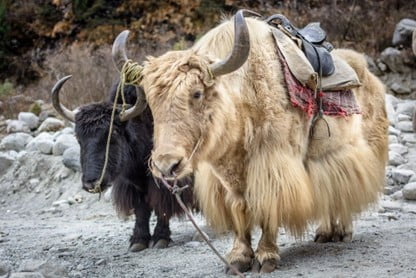
- It is a high-altitude bovine animal.
- IUCN : Vulnerable
- The yak plays a multidimensional socio-cultural-economic role for the pastoral nomads who rear it mainly for earning their nutritional and livelihood security due to the lack of other agricultural activity in the higher reaches of the Himalayan region where it is difficult for animals except the yak to survive
- Yaks are traditionally reared under a transhumance system which is primitive, unorganised and full of hardship.
- The yak population in the country has been decreasing at an alarming rate
- According to a census carried out in 2019, India has some 58,000 yaks – a drop of about 25% from the last livestock census conducted in 2012.
- It has become a major cause of concern for animal genetic diversity
- It could be attributed to less remuneration from the bovid, discouraging the younger generations from continuing with nomadic yak rearing.
- It is mainly because yak milk and meat are not a part of the conventional dairy and meat industry, their sale is limited to local consumers.
- The commercialisation of yak milk and meat products will lead to entrepreneurship development. Hence, yak is included as a food producing (milk and meat) animal in the Food Safety and Standards Regulation, 2011.
- Nutrient-loaded: yak milk is highly nutritious, rich in fat, contains essential minerals and has medicinal values.
- yak milk contains 78-82% water, 7.5-8.5% fat, 4.9-5.3% protein, 4.5-5.0% lactose and 12.3-13.4% solids-not-fat.
- products from yak milk are churkum, churpi, ghee and paneer.
- Yak meat is known to be lean.
- contains 74.8% moisture, 21.7% protein, 1.5% crude fat and 1.2% ash.
- NRC-Yak has developed a semi-intensive model of yak-rearing in which yaks are maintained in an open area as well as in paddock round the year.
About Food Safety and Standards Authority of India (FSSAI):
- It is an autonomous statutory body established under the Food Safety and Standards Act, 2006 (FSS Act).
- The Act aims to establish a single reference point for all matters relating to food safety and standards, by moving from multi- level, multi-departmental control to a single line of command.
- Ministry: Ministry of Health & Family Welfare.
- It comprises a Chairperson and twenty-two members out of which one – third are to be women. The Chairperson of FSSAI is appointed by the Central Government.
- The primary responsibility for enforcement is largely with the State Food Safety Commissioners.
Source: The Hindu
Syllabus
- Prelims – Science and Technology
In News: Chief of Naval Staff Admiral R. Hari Kumar said the integration of aircraft with the newly commissioned aircraft carrier INS Vikrant is likely to be accomplished by May or June next year.
- The Indian Navy’s first small ship was commissioned indigenously in 1960.
- INS Vikrant is 76% indigenous
- In the last seven years, 29 ships and submarines built in India have been commissioned.

MUST READ INS Vikrant
Source: The Hindu
Previous Year Question
Q.1) Which one of the following is the best description of ‘INS Astradharini’, that was in the news recently?
- Amphibious warfare ship
- Nuclear-powered submarine
- Torpedo launch and recovery vessel
- Nuclear-powered aircraft carrier
Syllabus
- Prelims – Science and Technology
In News: Dr Ishwar Gilada, who is the president of AIDS Society of India and governing council member of International AIDS Society said that India has done well by making antiretroviral therapy affordable and accessible to over 90 per cent of people living with HIV in the world.
- The theme of World AIDS Day 2022 is ‘Equalize’.
- ‘Undetectable AIDS is untransmittable’. Thus, each new HIV case is a missed opportunity.
About AIDS: AIDS
About AIDS progress:
- Antiretroviral therapy (ART) can result in undetectable viral load for those PLHIV on treatment within just a couple of months
- As in 2021 – 38.4 million people were living with HIV, out of which 1.7 million were children and 54% of all were women and girls.
- In 2021, as per the Joint United Nations Programme on HIV/AIDS (UNAIDS)
- 6,50,000 people died of AIDS-related diseases.
- 5 million people became newly infected– 4,000 new infections every day
- Number of people on HIV treatment increased by only 1.47 million in 2021, compared to net increases of more than 2 million people in previous years
- Global context: Out of all people living with HIV, 85 per cent knew their status, 75 per cent were accessing treatment and 68 per cent were virally suppressed in 2021.
- Indian context: According to UNAIDS, an estimated 2.4 million people were living with HIV in India in 2021 (including 70,000 children).
- Out of these 1.9 million or 77 per cent knew their HIV status; 1.6 million (or 65 per cent) were on life-saving antiretroviral therapy; and 1.3 million (55 per cent) had suppressed viral load.
- 63,000 people were newly infected with HIV in 2021 in India – 173 new infections every day or seven infections every hour.
- There were 42,000 AIDS-related deaths in 2021 (5 deaths every hour)
- Factors like lack of accountability, sub-optimal programme effectiveness, and complacency are slowing us down from reaching the goal of an AIDS-free world by 2030
- Measures to be taken such as science-backed tools and approaches to prevent HIV (human immunodeficiency virus) transmission, or diagnosing and treating persons living with HIV (PLHIV) so that they can live healthy lives.
Source Indian Express
Syllabus
- Mains – GS 2 (Governance)
Context: Recently, President Droupadi Murmu while addressing the delegates of a National Workshop on ‘Janjatiya Anusandhan – Asmita, Astitva evam Vikas’ said that the Indian Knowledge System (IKS) that the National Education Policy is currently emphasizing needs to incorporate the knowledge of indigenous tribes.
- According to the 2011 Census, the Scheduled Tribes account for 104 million representing 8.6% of the country’s population. The essential characteristics of these communities are:
- Primitive Traits; Geographical isolation; Distinct culture; Shy of contact with community at large; Economically backwards.
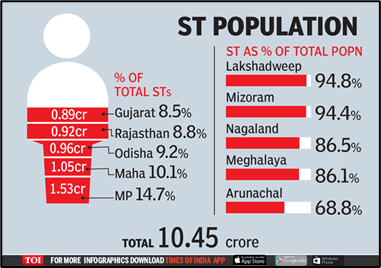
About Integrating tribal knowledge systems:
- Tribal knowledge systems represent inter-generational wisdom in band societies passed on to the present times through centuries of experience and learnings.
- Tribal societies have contemporary knowledge of nature due to continued closeness to forests, flora and fauna.
- Tribal methods are based on conservation of knowledge.
- For example, the awareness among tribals of Andaman & Nicobar about a wall of sea helped them against Tsunami in 2004.
Significance of Tribal Knowledge Systems:
- Tribal societies have contemporary knowledge of nature due to continued closeness to forests, flora and fauna. Mainstream societies have moved on to agricultural basis of society, and their cultural knowledge represents impressions of their tribal past, which no longer exists.
- While mainstream knowledge systems are based on rigorous refining and questioning of ideas through discussions and scientific verification, tribal methods are based on conservation of knowledge.
- Tribal knowledge systems are stored in songs and stories, while mainstream knowledge is preserved in books and recordings.
- Tribal knowledge systems promote integrated learning for the community. In mainstream society, knowledge and traditions have bifurcated, with traditions becoming a subject of study instead of mode of studying.
- Tribal knowledge systems are non-exclusionary and marked by equity.
- Mainstreams knowledge systems are mired in barriers like cost of education, patent protections, social exclusion etc.
Government of India Initiatives for Tribal welfare:
Eklavya Model Residential Schools
- The objective of EMRS is to provide quality middle and high-level education to Scheduled Tribe (ST) students in remote areas, not only to enable them to avail of reservation in high and professional education courses and as jobs in government and public and private sectors but also to have access to the best opportunities in education at par with the non-ST population.
Tribes India E-Marketplace:
- Tribes India E-Marketplace is India’s largest handicraft and organic products marketplace.
- The initiative aims to onboard 5 lakh tribal producers for sourcing various handicraft, handloom, and natural food products across the country and brings to you the best of tribal produce.
- The suppliers comprise individual tribal artisans, tribal SHGs, and Organisations/ Agencies/ NGOs working with tribals.
Vanabandhu Kalyan Yojana
- The Government of India, Ministry of Tribal Affairs has launched the Vanabandhu Kalyan Yojana (VKY) for the welfare of Tribals.
- KY aims at creating enabling environment for need-based and outcome-oriented holistic development of the tribal people.
Minor Forest Produce
- Minor Forest Produce (MFP) is more often than not determined by the traders instead of the self-sustained process of demand and supply.
- Implementing a scheme to ensure that such forest dwellers are not deprived of their due.
- Under the scheme maximum selling price for MFP is being implemented in schedule V States initially.
- A web-based portal has also been developed which indicates the current price of MFPs on a real-time basis across different mandis of States.
Van Dhan Scheme:
- The Van Dhan Scheme is an initiative of the Ministry of Tribal Affairs and TRIFED. It was launched on 14th April 2018 and seeks to improve tribal incomes through the value addition of tribal products.
- The scheme will be implemented through the Ministry of Tribal Affairs and TRIFED as Nodal Agency at the National Level.
- At the State level, the State Nodal Agency for MFPs and the District collectors are envisaged to play a pivot role in scheme implementation at the grassroots level.
Tribal museums:
- There are records of over 200 tribal freedom fighters across India who participated in about 85 instances of revolts and uprisings against colonial rule.
- To recognise this, 10 tribal freedom fighter museums are being set up in the States of Andhra Pradesh (Lambasingi), Chhattisgarh (Raipur), Goa (Ponda), Gujarat (Rajpipla), Jharkhand (Ranchi), Kerala (Kozhikode), Madhya Pradesh (Chhindwara), Manipur (Taminglong), Mizoram (Kelsey) and Telangana (Hyderabad) will showcase the contribution of tribal freedom fighters.
Way Forward:
- While mutual interaction is visible among tribal and mainstream culture, it is necessary to preserve tribal knowledge by appropriate documentation, including them in disaster management, policy making, thus making India truly inclusive in nature and spirit.
- As India celebrates its 75th year of Independence with ‘Azadi ka Amrit Mahostav’, Janjatiya Gaurav Diwas would be a thoughtful gift for our tribal community and a recall to Ram Rajya where the likes of Guha are given due respect, their cultural diversity is respected, and their contributions celebrated.
Additional Information:
Indian Knowledge System (IKS)
- Indian Knowledge System (IKS) is an innovative cell under Ministry of Education (MoE) at AICTE, New Delhi.
- It is established to promote interdisciplinary research on all aspects of IKS, preserve and disseminate IKS for further research and societal applications.
- It will actively engage in spreading the rich heritage of our country and traditional knowledge in the field of Arts and literature, Agriculture, Basic Sciences, Engineering & Technology, Architecture, Management, Economics, etc.
Functions of IKS:
- Facilitate and coordinate IKS based/related inter and transdisciplinary work done by various institutions in India and abroad including universities, institutions of national importance, R&D laboratories and different ministries and inspire private sector organisations to engage with it.
- Facilitate funding of various projects and develop mechanisms to undertake research.
- Establish, guide and monitor subject-wise interdisciplinary research groups of researchers from institutes, centres and individuals.
- Create and promote popularisation schemes.
- Make Policy recommendations wherever required for the promotion of IKS.
About National Commission for Scheduled Tribes
- The National Commission for Scheduled Tribes was established by amending Article 338 and inserting a new Article 338A in the Indian Constitution through 89th Amendment Act, 2003.
- The National Commission for Scheduled Tribes is a constitutional body.
- Its role is to safeguard the interests of the scheduled tribes or under any other order to the Government and to evaluate the working of such safeguards.
- The Union and every State Government shall consult the Commission on all major policy matters affecting Scheduled Tribes.
- The Commission and its officers participate in formulation of policies and in the developmental programmes for Scheduled Tribes including Tribal Sub-Plan.
Source: The Hindu
Previous Year Question
Q.1) If a particular area is brought under the Fifth Schedule of the Constitution of India, which one of the following statements best reflects the consequence of it? (2022)
- This would prevent the transfer of land of tribal people to non-tribal people.
- This would create a local self-governing body in that area.
- This would convert that area into a Union Territory.
- The State having such areas would be declared a Special Category State.
Q.2) At the national level, which ministry is the nodal agency to ensure effective implementation of the Scheduled Tribes and Other Traditional Forest Dwellers (Recognition of Forest Rights) Act, 2006? (2021)
- Ministry of Environment, Forest and Climatic change.
- Ministry of Panchayat Raj
- Ministry of Rural Development
- Ministry of Tribal Affairs
Syllabus
- Mains – GS 2 (Governance)
Context: On the International Day for Elimination of All Forms of Violence against Women (November 25), the brutal murder and mutilation of a young woman by her partner has drawn attention to intimate partner violence, also recognized under the Protection of Women from Domestic Violence Act 2005 (PWDVA) as a kind of domestic violence.
About Domestic Violence:
- Domestic violence can be defined as a pattern of behavior in any relationship that is used to gain or maintain power and control over an intimate partner.
- Abuse is physical, sexual, emotional, economic, or psychological actions or threats of actions that influence another person.
- This includes any behaviors that frighten, intimidate, terrorize, manipulate, hurt, humiliate, blame, injure, or wound someone.
- Domestic violence affects people of all socioeconomic backgrounds and education levels.
- Domestic violence is a punishable offence under Indian law. It is a violation of human rights.
Domestic violence in India:
National Family Health Survey-5 (2019-21):
- 32% of ever-married women aged 18-49 years have ever experienced emotional, physical, or sexual violence committed by their husbands, with more rural than urban women reporting experiences of domestic violence. This does not even capture the prevalence of violence by other family members too.
- Seeking help:
- The NFHS- 5 reports that only 14% of women who have experienced domestic violence have ever sought help, and this number is much lower in rural areas.
- Justification of violence:
- So ingrained are social norms about gender inequality that NFHS-5 data reports that women are more likely than men to justify a scenario in which it is acceptable for a husband to beat or hit his wife.
Issues associated with domestic violence:
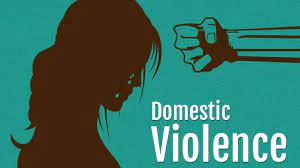
- Despite the laws existing on paper, women are still largely unable to access the law in practice. Its promise and provisions are unevenly implemented, unavailable and out of reach for most Indian women.
- the latest round of the National Family Health Survey-5 (2019-21) reveals that 32% of ever-married women aged 18-49 years have ever experienced emotional, physical, or sexual violence committed by their husbands, with more rural than urban women reporting experiences of domestic violence.
- Despite almost a third of women being subject to domestic violence, the National Family Health Survey-5 (2019-21) reports that only 14% of women who have experienced domestic violence have ever sought help, and this number is much lower in rural areas.
- Women who reported experiences of violence to the police were cynical about the outcome.
- Across many States, it is observed that the police were more likely to send women back to violent households to reconcile with the perpetrator or use violence against perpetrators as a deterrent instead of filing an official complaint or connecting women to protection officers and other service providers, as the PWDVA outlines they should.
- Several States are yet to implement Protection officers. And where they are in post, they are under-resourced, under-skilled and overworked, making their remit impossible.
- Sometimes Women do not report domestic violence incidents because they feel that things would change.
- women did not want to be a ‘burden’ on others, in particular their families. ‘
- women believed that they would become a problem or a source of ‘tension’ for their families, bringing them shame and dishonour, irrespective of the survivor’s level of education, caste, or class.
- The economic distress faced by millions due to the pandemic exacerbated the problem.
Role of the police:
- Women who reported experiences of violence to the police were cynical about the outcome.
- Though a small minority had positive experiences, for the majority of women, the police were part of the problem rather than a solution to violence.
- Across the States, it is heard that the police were more likely to send women back to violent households to reconcile with the perpetrator or use violence against perpetrators as a deterrent instead of filing an official complaint or connecting women to protection officers and other service providers, as the PWDVA outlines they should.
- Several States are yet to implement Protection officers and where they are in post, they are under-resourced, under-skilled, and overworked, making their remit impossible.
Governments Efforts:
- Protection of Women from Domestic Violence Act, 2005: a progressive legislation, was passed, promising a joined-up approach — involving civil and criminal protections — to support and protect women from violence within the household
- It is a gender-specific law enacted to protect women against domestic violence
- The Criminal Law (Amendment), Act 2013 was enacted for effective legal deterrence against sexual offences.
- Further, the Criminal Law (Amendment) Act, of 2018 was enacted to prescribe even more stringent penal provisions including the death penalty for the rape of a girl below the age of 12 years.
- The Government has set up the Nirbhaya Fund for projects for the safety and security of women, for which the Ministry of Women and Child Development is the nodal authority for appraising/ recommending the proposals/schemes to be funded under the Nirbhaya Fund.
- In order to coordinate various initiatives for women’s safety, MHA has set up a Women Safety Division.
- The government of India conducts awareness generation programmes and publicity campaigns on various laws relating to women and their rights through workshops, cultural programmes, seminars, training programmes, advertisements in print and electronic media etc.
Way Forward:
- The intervention should begin by focusing on gender equality in education since the quality of education received by women has not equipped them to question the patriarchy.
- the government should understand and recognise domestic violence of any form as a crime and not just a ‘family issue’.
- Trauma-informed institutional response, revamping of the support systems based on impact assessments and increasing the number of one-stop centres with adequate professionals are some of the other measures needed.
- There is a need for sustained and intensified campaigns and the strengthening of institutions with wider representation.
- Creating and publicising a directory of services which can be accessed by survivors and their relatives or friends with information and mobile numbers during a crisis.
- Data and Information systems must be strengthened for better evidence-informed policy to address the issue of domestic violence in India.
Source: The Hindu
Syllabus
- Mains – GS 2 International Relations
In News: India stands for a free, open and rules-based Indo-Pacific as it is important for the economic development of not only the region but also the wider global community. This was stated by Raksha Mantri Shri Rajnath Singh during his keynote address at the Indo-Pacific Regional Dialogue (IPRD) in New Delhi.
- It included the ‘Margdarshan’ session
- Raksha Mantri released a book, published by the National Maritime Foundation (NMF) titled ‘Coastal Security Dimensions of Maritime Security’.
- The IPRD is an annual apex-level international outreach of the Indian Navy that seeks to foster exchange of ideas and promote deliberations on maritime issues relevant to the Indo-Pacific.
Context:
- Throughout history, the maritime domain has been a crucial space in establishing new and emerging powers shaping regional dynamics and the larger security architecture.
- The emergence of the Indo-Pacific as a new geographic space—bringing together the Indian and the Pacific Oceans—represents the new strategic reality of the twenty-first century.
- India’s role in the Indo-Pacific is considered crucial by countries such as Australia, Japan, and the United States and is an important domain in India’s foreign policy.
What constitutes Indo-Pacific:
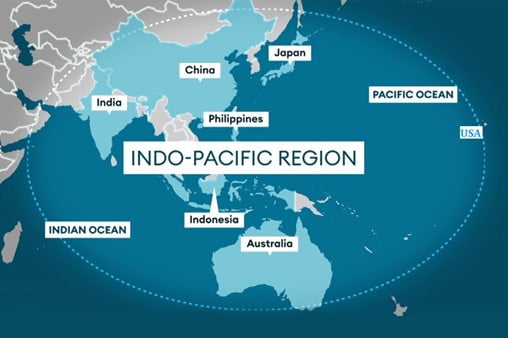
- An interconnected space between the Indian Ocean and the Pacific Ocean ranging from eastern Africa to western coast of the United States
- It is a product of growing forces of globalization, trade and geopolitics.
- It contains the world’s most crucial sea routes, the world’s most populous nations fuelling high energy demands on its rims and a stretch encapsulating finest global commons.
- The Indo-Pacific is adjudged to be the centre of the globe in terms of politics and economics.
- These island states are near key sea lines of communication (SLOCs) critical for the movement of goods and people in times of both peace and conflict.
- Access to key choke points and help expand and sustain naval presence across vast maritime domains.
- Example – Mozambique Channel, Bab-el-Mandeb Strait
Indo-Pacific initiatives:
- In 2016 India created a new division within the MEA, called the Indian Ocean Region Division (IOR), which brings together the island nations of Maldives, Mauritius, Seychelles, and Sri Lanka for better coordination of initiatives and policy in the Indian Ocean.
- Indo-Pacific Ocean Initiative launched during the East Asia Summit held in Bangkok, Thailand in 2019
- Important pillars – Regional cooperation and participation
- Vision of SAGAR i.e., Security and Growth for All in the Region.
- India-ASEAN Defence Ministers’ Meeting held in Cambodia
- ASEAN-India Initiative for women in UN Peace Keeping Operations contribute towards conflict resolution and humanitarian approach
- ASEAN-India Initiative on Marine Plastic Pollution Response towards improving the marine ecosystem
- Asia-Africa Growth Corridor, an initiative largely seen as a direct counter to China’s Maritime Silk Road (component of BRI) with Japan as a collaborating partner.
- Regional institutions such as ASEAN and the Indian Ocean Rim Association – The European Union and India have a shared interest in maintaining a rules-based order.
Challenges:
- China in India’s neighbourhood: China’s economic growth, combined with its military modernization, across the Indian and Pacific Oceans challenges the maritime security as well as widens the strategic and capacity gap with India.
- Increasing collaborations between China and island states such as Maldives, Mauritius, Seychelles, and Sri Lanka threaten India’s role of a security provider.
- Belt and Road initiative 2013
- China-Pakistan Economic Corridor (CPEC) 2017
- Sri Lankan government leased Hambantota Port to China in 2017
- Malé owed Beijing $1.4 billion in loans for projects.
- Deteriorating relations with Island nations
- In 2012, Maldives cancelled a $511 million international airport expansion contract with India-based GMR Group and gave it to China for $800 million.
- Weakening regional governance mechanisms – Lack of an agreed ground rule for navigation, climate change, maritime security and oceanic degradation.
- Uncertainty in relationships between US-China, US-Japan and US-South Korea
- ASEAN on side-lines: Individual ASEAN nations are being pulled into China’s orbit because they see that the economic cost of opposing China’s agenda is too high
Suggestions:
- Partnerships as a central pillar:
- Address capability gap with help from west such as QUAD
- Modi’s 2018 Shangri-La address provided a framework for India’s Indo-Pacific priorities.
- Connectivity and security:
- Maritime Domain Awareness (MDA) across the Indian Ocean of Indian Navy
- The IFC-IOR aims to provide a holistic picture of the entire Indian Ocean and international centre for the collation and sharing of information.
- Bilateral dialogues:
- New Delhi hosts annual 2+2 Dialogues with Australia, Japan, and the United States and has an annual defines dialogue with France.
- Annual Maritime Security Dialogues with Australia, the European Union, France, Japan, Myanmar, the United States, and Vietnam in 2019.
- QUAD – Australia, USA, India and Japan meeting of ministerial leaders
- Capacity building and infrastructural initiatives:
- In 2019, New Delhi met for the first time with the Pacific Islands Developing States (PSIDS) announcing a grant of $1 million to its members and a concessional line of credit of $150 million to Pacific Island countries for projects in solar power.
- Humanitarianism and Goodwill:
- Indian Navy is the first responder for humanitarian crises across the region due to its access through the IOR—in comparison to Beijing,
- Environmental concerns: due to climate change and global warming increasing threats to small island nations and littoral states
- Australia, Japan, and the United States became founding members of the Coalition for Disaster Resilient Infrastructure in 2019 – an Indian initiative
- UN Security Council: need to elevate the paradigm of collective security to a level of shared interests and security for all
Way forward:
- In the times when humanity is facing problems like climate change, Covid-19 pandemic & widespread deprivation, it is essential that we all work together to surmount these mammoth challenges, without being distracted by the destructive seduction of wars and conflicts.
- National security should not be considered as a zero-sum game and we should strive to create a win-win situation for all.
- Dialogue only civilised mechanism for resolving disputes & creating global order
Source: PIB
Baba’s Explainer – India’s Digital rupee: CBDC
Syllabus
- GS-3: Money & Banking; RBI and its monetary Policy
- GS-2: Government Policies and Interventions for Development in various sectors and Issues arising out of their Design and Implementation.
Context: Reserve Bank of India (RBI) has announced the launch of India’s much-awaited Central Bank Digital Currency (CBDC), a sort of official cryptocurrency, for retail users from December 1.
Read Complete Details on India’s Digital rupee: CBDC
Practice MCQs
Q.1) With reference to the Indian climate, consider the following statements:
- In recent years, excessive rainfall in southern peninsular is due to El Nino.
- Ocean warming is strong in the Arabian Sea because it receives excess heat through atmospheric tunnels and bridges.
Which of the statements given below is/are correct?
- 1 only
- 2 only
- Both 1 and 2
- Neither 1 nor 2
Q.2) With reference to ‘INS Vikrant’, consider the following statements:
- It is India’s first 100% indigenous aircraft carrier.
- It was built by Mazagaon Shipyard limited.
- It is nuclear powered generating around 80MW of energy.
Which of the following statements are correct:
- 1 only
- 1 and 2 only
- 1, 2 and 3
- None of the above
Q.3) Consider the following statements regarding Indian Knowledge System (IKS):
- Indian Knowledge System (IKS) is an innovative cell under Ministry of Tribal Welfare
- It will actively engage in spreading the rich heritage of our country and traditional knowledge in the field of Arts and literature, Agriculture, Basic Sciences, Engineering & Technology, etc.
Which of the above is/are correct?
- 1 only
- 2 only
- Both 1 and 2
- Neither 1 nor 2
Comment the answers to the above questions in the comment section below!!
ANSWERS FOR ’30th November 2022 – Daily Practice MCQs’ will be updated along with tomorrow’s Daily Current Affairs.st
ANSWERS FOR 29th November – Daily Practice MCQs
Q.1) – c
Q.2) – a
Q.3) – b












